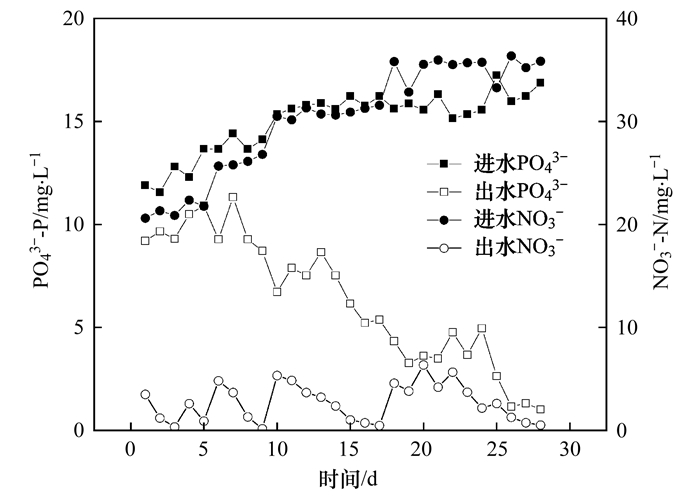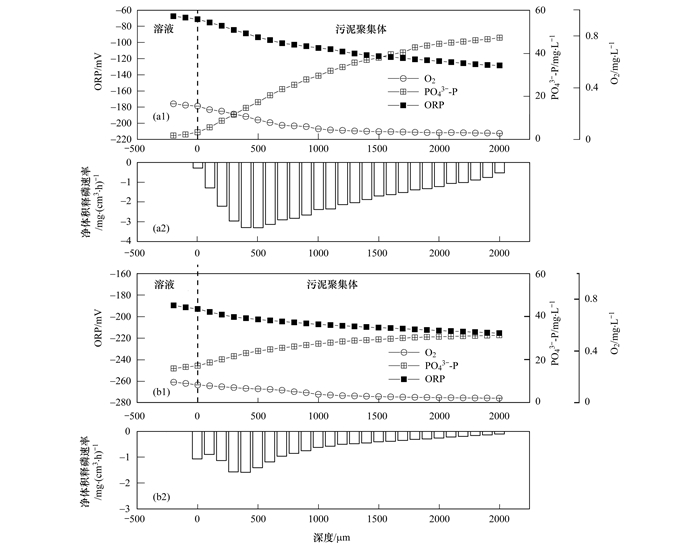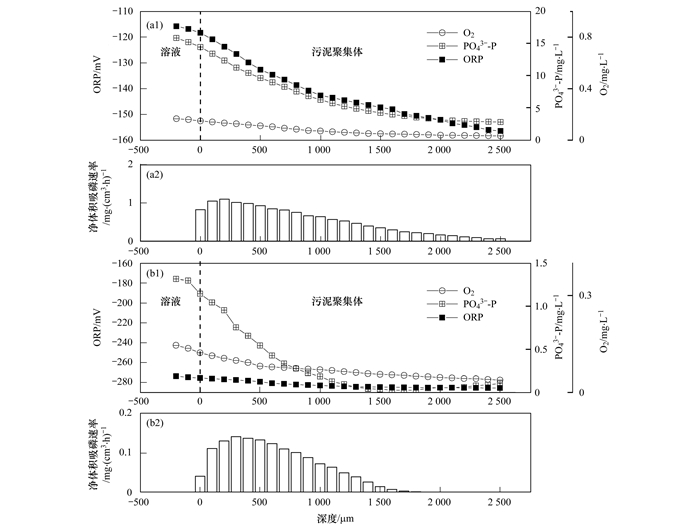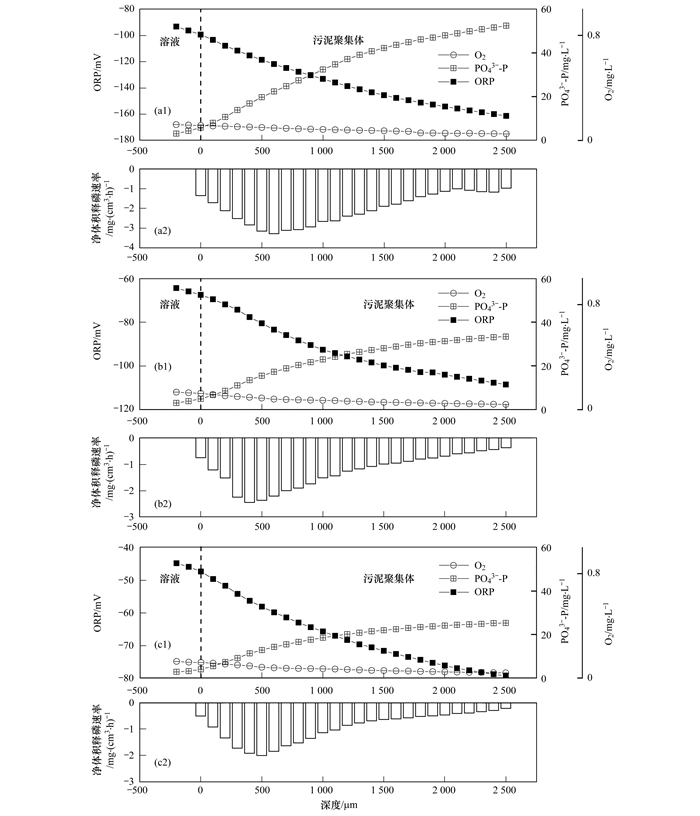2. 陕西省膜分离技术研究院陕西省膜分离重点实验室, 西安 710055;
3. 陕西省现代建筑设计研究院, 西安 710024
2. Key Laboratory of Membrane Separation of Shaanxi Province, Research Institute of Membrane Separation Technology of Shaanxi Province, Xi'an 710055, China;
3. Shaanxi Modern Architecture Design & Research Institute, Xi'an 710024, China
反硝化除磷是指在缺氧条件利用NOx-氧化胞内聚合物, 同时完成反硝化脱氮和除磷的生物过程[1, 2].因可“一碳两用”, 具有节省碳源、降低曝气量和污泥产量[3~9]的优点, 成为本领域的研究热点之一.研究者通过试验研究获得了反硝化除磷的影响因素及运行参数[10~15], 但大部分停留在反应器去除效能等宏观层面.
微生物活性是反应器去除效能的决定因素, 有研究者利用尖端细小的微电极测定污泥基团(污泥聚集体或生物膜等)内部物质浓度的空间分布特征, 获得了原位生物活性, 从而为污水处理问题诊断或优化提供依据[16].目前, 研究对象多针对脱氮系统[17~21], 对除磷污泥聚集体原位生物活性的研究尚少见报道.Lee等[22]利用磷酸盐微电极, 测定了厌氧条件下污泥内的磷浓度的空间分布特性, 首次揭示了除磷菌的原位生物活性.吕永涛等[23]研究获得了污水厂A2/O工艺沿程处理单元除磷菌活性的变化规律, 为污水处理参数的优化提供了一定依据.
本文在SBR系统中实现了反硝化除磷的启动与稳定运行.在此基础上, 利用微电极定量研究了厌氧和缺氧段污泥聚集体内的原位除磷生物活性以及有机物浓度对释磷活性的影响, 通过揭示反硝化除磷的原位生物活性, 以期为系统的优化提供一定的依据.
1 材料与方法 1.1 试验装置采用圆柱形SBR反应器, 内径15 cm, 高34 cm, 有效容积5 L, 排水比为0.6.采用磁力搅拌器使泥水混合均匀, 通过PLC自动控制反应器的连续运行.
1.2 运行操作反应器每天运行3个周期, 单周期运行时间为8 h, 具体包括:厌氧进水(3 L)5 min, 厌氧搅拌164 min, 沉淀排水(3 L)47 min, 缺氧进水(3 L)5 min, 缺氧搅拌216 min, 沉淀排水(3 L)47 min.
1.3 接种污泥与试验用水反应器所用污泥取自西安某污水处理厂, 接种后初始污泥浓度约为4000 mg·L-1, 稳定运行期间控制SRT为15 d, 污泥浓度维持在(3700±200)mg·L-1, SVI约为52.5 mL·g-1.
进水基质人工配置, 厌氧段主要为乙酸钠和NaHCO3, 其中COD 200~330mg·L-1, NH4+-N 10~30mg·L-1, NaHCO3 200mg·L-1.缺氧段主要为KH2PO4、KNO3和NaHCO3, 其中NO3--N 19.9~58mg·L-1, PO43--P 19~26mg·L-1, NaHCO3 200mg·L-1.另外, 每升进水中加入1 mL的微量元素, 成分按文献[24]配制.
1.4 化学分析方法按文献[25]的方法进行测定, 其中, 氨氮采用纳氏试剂分光光度法, 化学需氧量采用重铬酸钾法, 亚硝氮采用N-(1-萘基)-乙二胺比色法, 硝氮采用盐酸-氨基磺酸比色法, 磷酸盐采用钼酸盐分光光度法, 溶解氧采用哈希便携式溶氧仪.
1.5 微电极系统与测试方案 1.5.1 微电极及性能采用氧化还原电位、溶解氧和磷酸盐微电极均为课题组自制.其中, 氧化还原电位、溶解氧微电极尖端直径小于25 μm, 响应时间在65 s内, 标准曲线的R2=0.995±0.002.磷酸盐微电极尖端直径约为20 μm, 标准曲线的R2>0.992, 响应时间小于90 s.
1.5.2 微电极测试装置与方法采用升流式测试槽[18], 通过开启蠕动泵将厚度约为5000 μm的污泥悬浮在丝状网上[26, 27]. 30 min后, 待传质稳定后开始测量.由于污泥层中的物质浓度呈对称分布, 所以本试验测定0~2500 μm的上层深度.
1.5.3 试验方案(1) 反硝化除磷污泥聚集体的原位生物活性 分别在厌氧初期(反应初始1 min)、厌氧末期(反应最后1 min)、缺氧初期(反应初始1 min)、缺氧末期(反应最后1 min)各取100 mL泥水混合液, 放置在微电极测试槽里, 使污泥悬浮在丝状网上, 30 min后开始测定环境及物质的空间浓度.
(2) COD浓度对厌氧释磷原位活性影响 厌氧反应初始1 min取泥水混合液100 mL, 完成泥水分离后置于丝状网上, 测试槽中分别配置COD为150、250和350 mg·L-1的基质进行微电极测试.
每个样品利用每种微电极分别测量3次, 试验结果取3次试验平均值.
1.6 净体积产生/消耗速率计算根据污泥聚集体内PO43--P的空间浓度, 利用Fick第二定律, 计算除磷菌的净体积产生/消耗速率[28, 29].其中, 负值表示产生速率, 正值表示消耗速率.
2 结果与讨论 2.1 SBR系统反硝化除磷的启动与运行性能通过逐步提升进水COD、PO43-及NO3-的浓度, 实现了反硝化除磷的启动, 具体见图 1.从中可见, 随着驯化时间的增长, 除磷效率逐渐增加.第1 d, 除磷量为2.70mg·L-1, 表明接种污泥中存在一定的反硝化聚磷菌.第2~10 d, 除磷量由1.90mg·L-1增至8.63mg·L-1; 之后, 逐渐升至14.91mg·L-1, 并趋于稳定, 反应器具备较高的除磷能力.

|
图 1 启动阶段SBR反应器缺氧段吸磷和NO3--N去除率变化情况 Fig. 1 Changes in phosphorus uptake and the NO3--N removal rate in the anoxic stage of the SBR reactor during the start-up phase |
NO3-的去除几乎与除磷效果同步变化, 前10 d, NO3--N进水浓度为20~26mg·L-1, 出水NO3--N浓度在0.16~4.82mg·L-1间波动.为进一步满足除磷所需电子供体, 第10 d至15 d, 进水NO3--N浓度提高至30mg·L-1, 去除率由82.52%逐渐提高至92.23%; 第18 d起, NO3--N浓度升至35mg·L-1, 去除率逐渐稳定在97.00%以上, 获得了稳定的反硝化除磷效果.
2.2 反硝化除磷污泥聚集体原位除磷活性 2.2.1 厌氧段污泥聚集体内释磷的原位生物活性厌氧段污泥聚集体内释磷原位生物活性的变化规律见图 2.由图 2(a)可见, 厌氧初始1 min, DO和ORP随深度增加均呈降低的趋势, 其中, DO由0.28mg·L-1降至0.05mg·L-1, ORP由-67.58 mV降至-128.41 mV, 可知污泥聚集体内部为厌氧环境.PO43--P浓度呈逐渐升高的趋势, 最大值为47.18mg·L-1.经计算, 其最大释磷速率发生在表层500 μm左右, 达到3.30 mg·(cm3·h)-1.

|
(a)厌氧初始1 min; (b)厌氧末期1 min 图 2 厌氧段污泥聚集体内浓度空间分布及净体积释磷速率 Fig. 2 Spatial distribution of the concentration and net volume release rate of PO43--P in the anaerobic sludge aggregates |
由图 2(b)可见, 厌氧末期1 min, DO与ORP的变化趋势同厌氧初期, ORP最低降至-215.46 mV, 表明随着反应进行, 反应器ORP进一步降低; PO43--P浓度由15.88mg·L-1升至31.32mg·L-1, 最大净体积释磷速率发生在表层400 μm处, 为1.60mg·(cm3·h)-1.
综上所述, 相比于厌氧初期, 末期的最大净体积释磷速率大大减小, 仅为初期的一半左右.污泥深层区域(>1000 μm), 厌氧末期的释磷反应基本停止.此外, 最大净体积释磷速率均发生在表层400~500 μm处, 此处的ORP分别为-93.62 mV(初期)和-201.63 mV(末期), 说明, 碳源充足条件下, 只要ORP低于-93.62 mV均可获得最高释磷速率.与宏观试验发现ORP能指示厌氧释磷的结果相一致[17, 18].另外, 当污泥聚集体(生物膜或颗粒污泥)厚度超过500 μm, 可能会因传质受限影响释磷速率.
2.2.2 缺氧段污泥聚集体内吸磷的原位生物活性缺氧段污泥聚集体内吸磷速率, 结果见图 3.由图 3(a)可见, 缺氧初始1 min, 污泥聚集体内DO浓度变化不大, 由0.17mg·L-1降至0.03mg·L-1; ORP迅速降低, 由表层的-115.76 mV降至-156.46 mV; PO43--P浓度呈下降趋势, 由15.88mg·L-1降至2.80mg·L-1.经计算, 最大净体积吸磷速率发生在200 μm处, 为1.10mg·(cm3·h)-1.

|
(a)缺氧初始1 min; (b)缺氧末期1 min 图 3 缺氧段污泥聚集体内浓度分布及吸磷净体积速率 Fig. 3 Spatial distribution of the concentration and net volume uptake rate of PO43--P in the anoxic period sludge aggregates |
由图 3(b)可见, 缺氧末期1 min, DO浓度分布与初期几乎一样; ORP较初期更低, 由-273.68 mV降至-285.49 mV, PO43--P浓度呈减小的趋势, 从污泥表层的1.32mg·L-1降至0.10mg·L-1.经计算, 最大净体积吸磷速率发生在表层300 μm, 仅为0.14mg·(cm3·h)-1.此外, 在1800 μm以下的深层区域, PO43--P浓度略有上升, 发生轻微的释磷现象.
综上, 污泥聚集体内反硝化吸磷的最大净体积速率为1.10mg·(cm3·h)-1, 仅为最大释磷速率的1/3左右.因此, 缺氧段需要更多的反应时间.缺氧末期吸磷反应很微弱, 且在污泥聚集体深处发生了“二次释磷”现象, 与宏观研究结果相一致[22].笔者推测可能是由于缺氧末期电子受体NO3-不足发生了内源释磷.因此, 为保证除磷效果反应器应严格控制缺氧段的运行时间.
2.3 COD浓度对污泥聚集体内原位释磷活性的影响在厌氧初始1 min取样, 研究不同COD浓度对污泥聚集体内原位释磷活性的影响, 结果见图 4.从中可知, 3组试验中DO变化值较小, 均为0.07~0.09mg·L-1.随着COD浓度(mg·L-1)由350降至250和150, ORP在整个污泥聚集体中的变化值呈降低趋势, 分别为68.00、44.07和34.56 mV, 最大释磷净体积速率分别由3.27 mg·(cm3·h)-1降至2.44 mg·(cm3·h)-1和2.01 mg·(cm3·h)-1.表明高浓度的COD, 同时降低了ORP并提高了释磷速率.此外, 随着初始COD浓度的降低, 快速释磷区域向污泥聚集体的表层收窄, 原因是低COD浓度导致传质减弱, 使污泥整体释磷活性降低.

|
(a)COD浓度为350 mg·L-1; (b)COD浓度为250 mg·L-1; (c)COD浓度为150 mg·L-1 图 4 COD浓度对污泥聚集体内浓度分布及净体积释磷速率的影响 Fig. 4 Effect of the COD concentration on the concentration distribution in the sludge aggregates and the net volume release rate of PO43--P |
(1) 反硝化除磷污泥聚集体内部, 原位释磷活性远高于吸磷活性, 最大释磷速率是吸磷速率的3倍.
(2) 厌氧和缺氧段末期, 虽然污泥聚集体内的ORP均进一步降低, 但因浓度降低导致基质受限, 其释磷、吸磷速率仅为初期的1/2和1/8左右.
(3) 随着COD浓度的降低, 反硝化除磷污泥聚集体内净体积释磷速率呈降低趋势, 且快速释磷区域向表层收窄.
| [1] | Tian W D, Ma C, Lin Y, et al. Effect of Mg/Ca molar ratios on characteristics of anaerobic-anoxic denitrifying dephosphatation[J]. Bioresource Technology, 2017, 240: 94-97. DOI:10.1016/j.biortech.2017.01.063 |
| [2] | Dai H L, Wu Y F, Peng L H, et al. Effects of calcium on the performance, bacterial population and microbial metabolism of a denitrifying phosphorus removal system[J]. Bioresource Technology, 2017, 243: 828-835. DOI:10.1016/j.biortech.2017.07.039 |
| [3] | Lee J K, Choi C K, Lee K H, et al. Mass balance of nitrogen, and estimates of COD, nitrogen and phosphorus used in microbial synthesis as a function of sludge retention time in a sequencing batch reactor system[J]. Bioresource Technology, 2008, 99(16): 7788-7796. DOI:10.1016/j.biortech.2008.01.057 |
| [4] | Wang J L, Peng Y Z, Wang S Y, et al. Nitrogen removal by simultaneous nitrification and denitrification via nitrite in a sequence hybrid biological reactor[J]. Chinese Journal of Chemical Engineering, 2008, 16(5): 778-784. DOI:10.1016/S1004-9541(08)60155-X |
| [5] | Bortone G, Libelli S M, Tilche A, et al. Anoxic phosphate uptake in the dephanox process[J]. Water Science and Technology, 1999, 40(4-5): 177-185. DOI:10.2166/wst.1999.0590 |
| [6] |
王亚宜, 彭永臻, 王淑莹, 等. 反硝化除磷理论、工艺及影响因素[J]. 中国给水排水, 2003, 19(1): 33-36. Wang Y Y, Peng Y Z, Wang S Y, et al. Denitrifying phosphorus removal theory, technology and the affecting factors[J]. China Water & Wastewater, 2003, 19(1): 33-36. DOI:10.3321/j.issn:1000-4602.2003.01.010 |
| [7] |
王晓霞, 王淑莹, 赵骥, 等. SPNED-PR系统内PAOs-GAOs的竞争关系及其氮磷去除特性[J]. 中国环境科学, 2018, 38(2): 551-559. Wang X X, Wang S Y, Zhao J, et al. The competitive relationships of PAOs-GAOs in simultaneous partial nitrification-endogenous denitrification and phosphorous removal (SPNED-PR) systems and their nutrient removal characteristics[J]. China Environmental Science, 2018, 38(2): 551-559. DOI:10.3969/j.issn.1000-6923.2018.02.017 |
| [8] |
韦佳敏, 蒋志云, 程诚, 等. ABR-MBR反硝化除磷工艺的启动及稳定运行[J]. 环境科学, 2019, 40(2): 808-815. Wei J M, Jiang Z Y, Cheng C, et al. Start-up and stable operation of ABR-MBR denitrifying phosphorus removal process[J]. Environmental Science, 2019, 40(2): 808-815. |
| [9] |
李伟光, 李东辉, 姚杰, 等. 污泥龄对BBSNP工艺反硝化除磷脱氮效能的影响[J]. 中国给水排水, 2020, 36(17): 13-17. Li W G, Li D H, Yao J, et al. Effect of sludge retention time on nitrogen and phosphorus removal Efficiency of bi-bio-selector for nitrogen and phosphorus removal process[J]. China Water Wastewater, 2020, 36(17): 13-17. |
| [10] |
缪新年, 汪倩, 郭凯成, 等. ABR-MBR耦合工艺启动及优化反硝化除磷性能[J]. 环境科学, 2020, 41(9): 4150-4160. Miao X N, Wang Q, Guo K C, et al. Start-up and optimization of denitrifying phosphorus removal in ABR-MBR coupling process[J]. Environmental Science, 2020, 41(9): 4150-4160. |
| [11] | Dulekgurgen E, Ovez S, Artan N, et al. Enhanced biological phosphate removal by granular sludge in a sequencing batch reactor[J]. Biotechnology Letters, 2003, 25(9): 687-693. DOI:10.1023/A:1023495710840 |
| [12] |
赵凯亮, 刘安迪, 南彦斌, 等. HRT对改良式A2/O-BAF反硝化除磷脱氮的影响[J]. 环境科学, 2020, 41(6): 2771-2778. Zhao K L, Liu A D, Nan Y B, et al. Effect of HRT on denitrifying phosphorus and nitrogen removal in modified A2/O-BAF[J]. Environmental Science, 2020, 41(6): 2771-2778. |
| [13] | Azhdarpoor A, Mohammadi P, Dehghani M. Simultaneous removal of nutrients in a novel anaerobic-anoxic/aerobic sequencing reactor: removal of nutrients in a novel reactor[J]. International Journal of Environmental Science and Technology, 2016, 13(2): 543-550. DOI:10.1007/s13762-015-0871-5 |
| [14] | Kumar S, Quaff A R. Treatment of domestic wastewater containing phosphate using water treatment sludge through UASB-clariflocculator integrated system[J]. Environment, Development and Sustainability, 2020, 22(5): 4537-4550. DOI:10.1007/s10668-019-00396-3 |
| [15] |
韦佳敏, 黄慧敏, 程诚, 等. 污泥龄及pH值对反硝化除磷工艺效能的影响[J]. 环境科学, 2019, 40(4): 1900-1905. Wei J M, Huang H M, Cheng C, et al. Effect of sludge retention time and pH on the denitrifying phosphorus removal process[J]. Environmental Science, 2019, 40(4): 1900-1905. |
| [16] | Li B K, Bishop P L. Micro-profiles of activated sludge floc determined using microelectrodes[J]. Water Research, 2004, 38(5): 1248-1258. DOI:10.1016/j.watres.2003.11.019 |
| [17] | Lv Y T, Ju K, Wang L, et al. Effect of pH on nitrous oxide production and emissions from a partial nitritation reactor under oxygen-limited conditions[J]. Process Biochemistry, 2016, 51(6): 765-771. DOI:10.1016/j.procbio.2016.02.017 |
| [18] | Lv Y T, Ju K, Sun T, et al. Effect of the dissolved oxygen concentration on the N2O emission from an autotrophic partial nitritation reactor treating high-ammonium wastewater[J]. International Biodeterioration & Biodegradation, 2016, 114: 209-215. |
| [19] | Kinh C T, Suenaga T, Hori T, et al. Counter-diffusion biofilms have lower N2O emissions than co-diffusion biofilms during simultaneous nitrification and denitrification: insights from depth-profile analysis[J]. Water Research, 2017, 124: 363-371. DOI:10.1016/j.watres.2017.07.058 |
| [20] | Zhou X, Zhang Z Q, Zhang X N, et al. A novel single-stage process integrating simultaneous COD oxidation, partial nitritation-denitritation and anammox (SCONDA) for treating ammonia-rich organic wastewater[J]. Bioresource Technology, 2018, 254: 50-55. DOI:10.1016/j.biortech.2018.01.057 |
| [21] | Cao Y F, Zhang C S, Rong H W, et al. The effect of dissolved oxygen concentration (DO) on oxygen diffusion and bacterial community structure in moving bed sequencing batch reactor (MBSBR)[J]. Water Research, 2017, 108: 86-94. DOI:10.1016/j.watres.2016.10.063 |
| [22] | Lee W H, Seo Y, Bishop P L. Characteristics of a cobalt-based phosphate microelectrode for in situ monitoring of phosphate and its biological application[J]. Sensors and Actuators B: Chemical, 2009, 137(1): 121-128. DOI:10.1016/j.snb.2008.10.032 |
| [23] |
吕永涛, 徒彦, 吴浩伟, 等. A2/O工艺中污泥聚集体内部除磷菌的原位活性研究[J]. 中国给水排水, 2019, 35(17): 31-36, 55. Lü Y T, Tu Y, Wu H W, et al. In-situ activity of dephosphorization bacteria in sludge aggregates in A2/O process[J]. China Water & Wastewater, 2019, 35(17): 31-36, 55. |
| [24] | Zhou Y, Pijuan M, Yuan Z G. Development of a 2-sludge, 3-stage system for nitrogen and phosphorous removal from nutrient-rich wastewater using granular sludge and biofilms[J]. Water Research, 2008, 42(12): 3207-3217. DOI:10.1016/j.watres.2008.04.012 |
| [25] | 国家环境保护总局. 水和废水监测分析方法[M]. ((第四版)). 北京: 中国环境科学出版社, 2002: 258-284. |
| [26] | Lee W H, Bishop P L. In situ microscale analyses of activated sludge flocs in the enhanced biological phosphate removal process by the use of microelectrodes and fluorescent in situ hybridization[J]. Journal of Environmental Engineering, 2010, 136(6): 561-567. DOI:10.1061/(ASCE)EE.1943-7870.0000194 |
| [27] |
王亚宜, 彭永臻, 王淑莹, 等. 碳源和硝态氮浓度对反硝化聚磷的影响及ORP的变化规律[J]. 环境科学, 2004, 25(4): 54-58. Wang Y Y, Peng Y Z, Wang S Y, et al. Effect of carbon source and nitrate concentration on denitrifying dephosphorus removal and variation of ORP[J]. Environmental Science, 2004, 25(4): 54-58. |
| [28] | Kim K S, Yoo J S, Kim S, et al. Relationship between the electric conductivity and phosphorus concentration variations in an enhanced biological nutrient removal process[J]. Water Science & Technology, 2007, 55(1-2): 203-208. |
| [29] |
姜欣欣. A2SBR反硝化除磷系统的试验研究[D]. 哈尔滨: 哈尔滨工业大学, 2007. 7. Jiang X X. Study on A2SBR denitrifying phosphorus removal system[D]. Harbin: Harbin Institute of Technology, 2007. 7. |
 2021, Vol. 42
2021, Vol. 42


